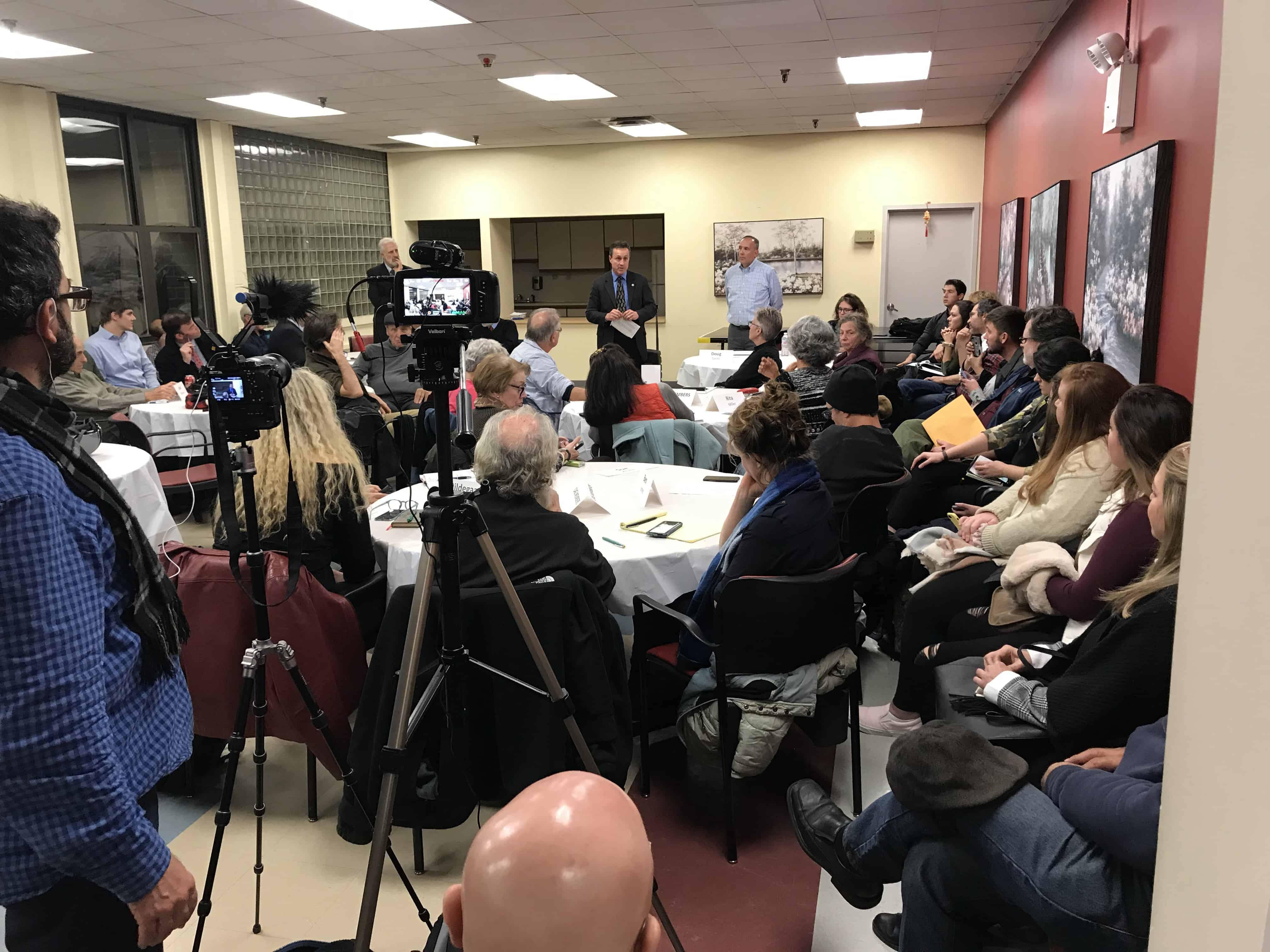
Gowanus Canal Community Advisory Group (CAG) members received updates from government and city agencies at the general monthly meeting, held November 27. The biggest surprise involved a last minute request by the NYC DEP to substitute a giant tunnel, instead of the planned sewage retention tanks ordered by the EPA, to capture raw sewage that now is dumped into the Gowanus during rainstorms
EPA lawyer Brian Carr also told the audience that possibility of the tank being placed in Thomas Greene Park was off the table. This was because the city has used eminent domain to take over properties across the street for the containment facility
EPA Regional Administrator Peter Lopez, in the middle of a long presentation to the CAG, dropped the bombshell. After finally winning their battle to take over two industrial buildings to build the tank, they have now approached the EPA with a concept to replace the tank proposal at Nevins and Butler Streets, with an “alternate structure-like tunnel or series of tunnels.” The tunnel concept was floated around “sometime during the summer,” but not officially announced until now. It was explained the tunnel would serve as a mechanism for water storage, instead of using a concrete underground tank, as suggested by the EPA, and used by DEP at other facilities.
“We’re trying to understand the pros and cons of that, and ultimately the decision from EPA will be “What does that mean for construction progression, timeframe, and – ultimately – tunnel versus tank? Is there an environmental benefit that may come from one or the other?” Lopez said.
Lopez made it clear that he is most interested in hearing from DEP if any additional environmental benefits could result from this tunnel proposal. He also emphasized to those in attendance that this is currently at a very cursory level of review. Nonetheless, many in the audience were kind of shocked.
DEP Project Coordinator Kevin Clarke provided some very preliminary details, saying the tunnel would be between 125 and 155 feet deep and would follow the alignment of the 1.8-mile long canal. Possible diameters and combined sewage overflow (CSO) retention rates were not mentioned. He said the storage volume would be more than the combined storage volume of two tanks.
“We’re currently proposing 16 to 17 million gallons, although that’s something that would need to be further evaluated through some detailed planning,” he said.When Chrissy Remein of Riverkeeper asked Clarke about DEP’s motivation for this potential change, he responded that it came down to costs, which were not revealed during the meeting.
“As we were developing the plans for [Flushing Bay and Newtown Creek] projects, we were proceeding with the planning and design of the two tanks for Gowanus and the costs of the tanks continued to increase. The tunnel alternative looked more attractive,” Clarke said. “We saw that potentially pivoting to a tunnel could add some additional benefits – as far as scalability into the future, potentially additional CSO capture, potentially less construction impacts, eventually less footprints.”
The Newtown Creek project, for example, which has proposed a 2.5-mile long tunnel alternative to capture sewage runoff, has options of four preliminary tunnel routes. The volume of the tunnel ultimately determines the preliminary probable bid costs.
EPA Region 2 Superfund Director Walter Mugdan also later explained that a headhouse with pumps and above-ground mechanisms would still be necessary.
Canal Clean-up Progress
The 4th Street Turning Basin Dredging and Capping Pilot Project has finally been completed after 13 months.
“It’s the first time a portion of the canal has a clean bottom in 150 years!” beamed EPA remedial project manager Christos Tsiamis.
As a result, this process has helped EPA determine which means and methods will be used in continuing to clean up the canal.
“From a technical point of view, by spring, we will be able to start the countdown of the clean-up in months, not in years!” Tsiamis exclaimed.
What’s Next?
Lopez said that EPA is not in the position to say tunnel over tank (or vice versa) yet; right now, EPA is proceeding with the tank concept until DEP provides more information.
“We don’t even know if the tunnel concept is viable. We don’t know if it would be acceptable,” Lopez explained. “So, our recommendation is – as the discussion gets more serious – to have the city tell us more about it. Just because they talk about it doesn’t mean that’s the direction [we’re] headed.”
Mugdan followed up, telling the room that the decision would have to be made in the relatively near future. A presentation will be made by DEP next year.
The first CAG meeting of 2019 will take place on Tuesday, January 22, at 6:30 pm at Mary Star of the Sea Senior Apartments (41 1st Street). All CAG meetings are open to the public – one need not be a member to attend. If anyone is interested in joining the Gowanus Canal CAG, visit gowanuscag.org.









2 Comments
Pingback: DEP Proposes Tunnel As Alternative To CSO Tanks For Gowanus Superfund - BKLYNER
The DEP expenses for the holding tanks is the one part of the superfund cleanup that taxpayers will pickup the tab for. It is very important that news coverage on DEP decisions includes discussion on what DEP is proposing to spend.